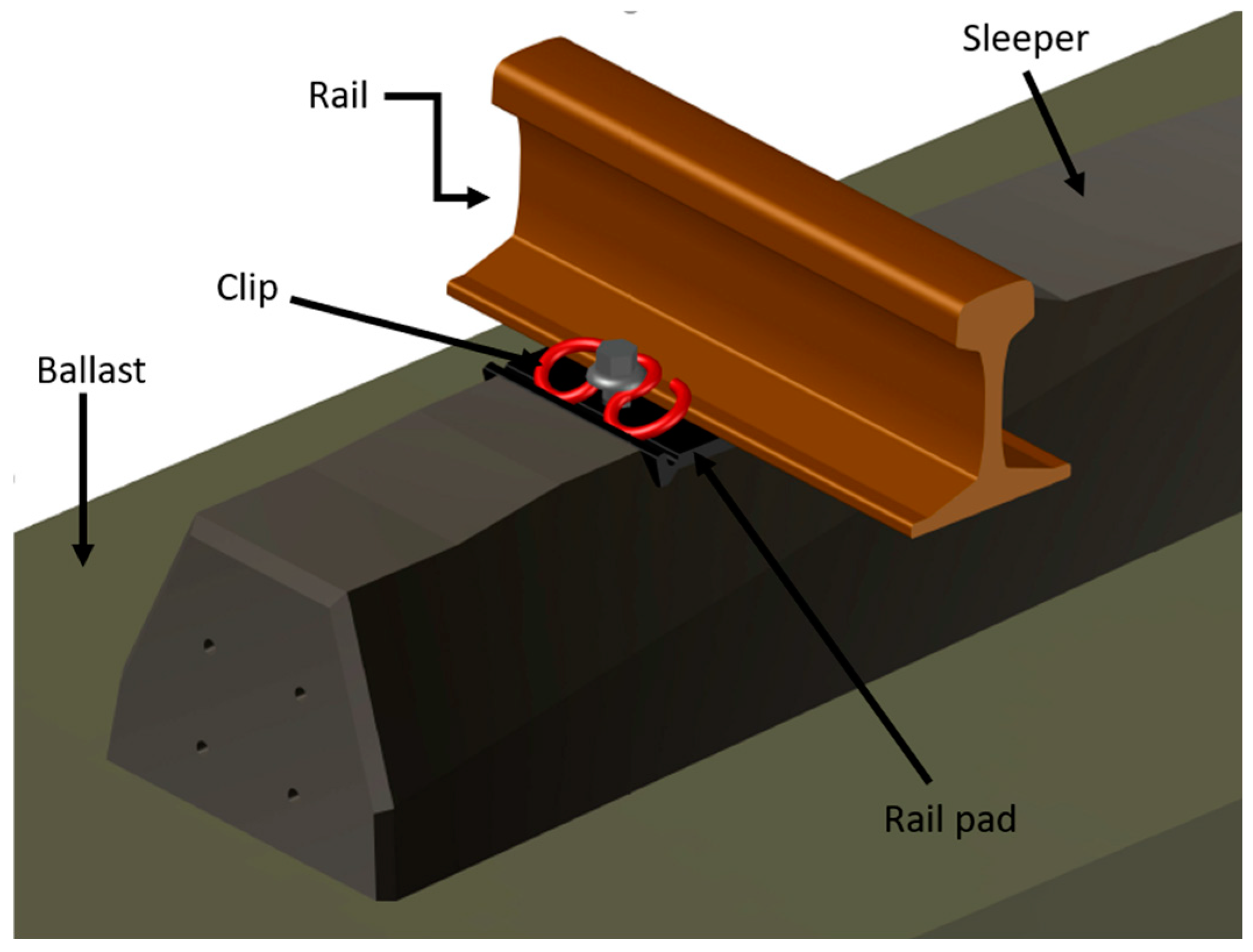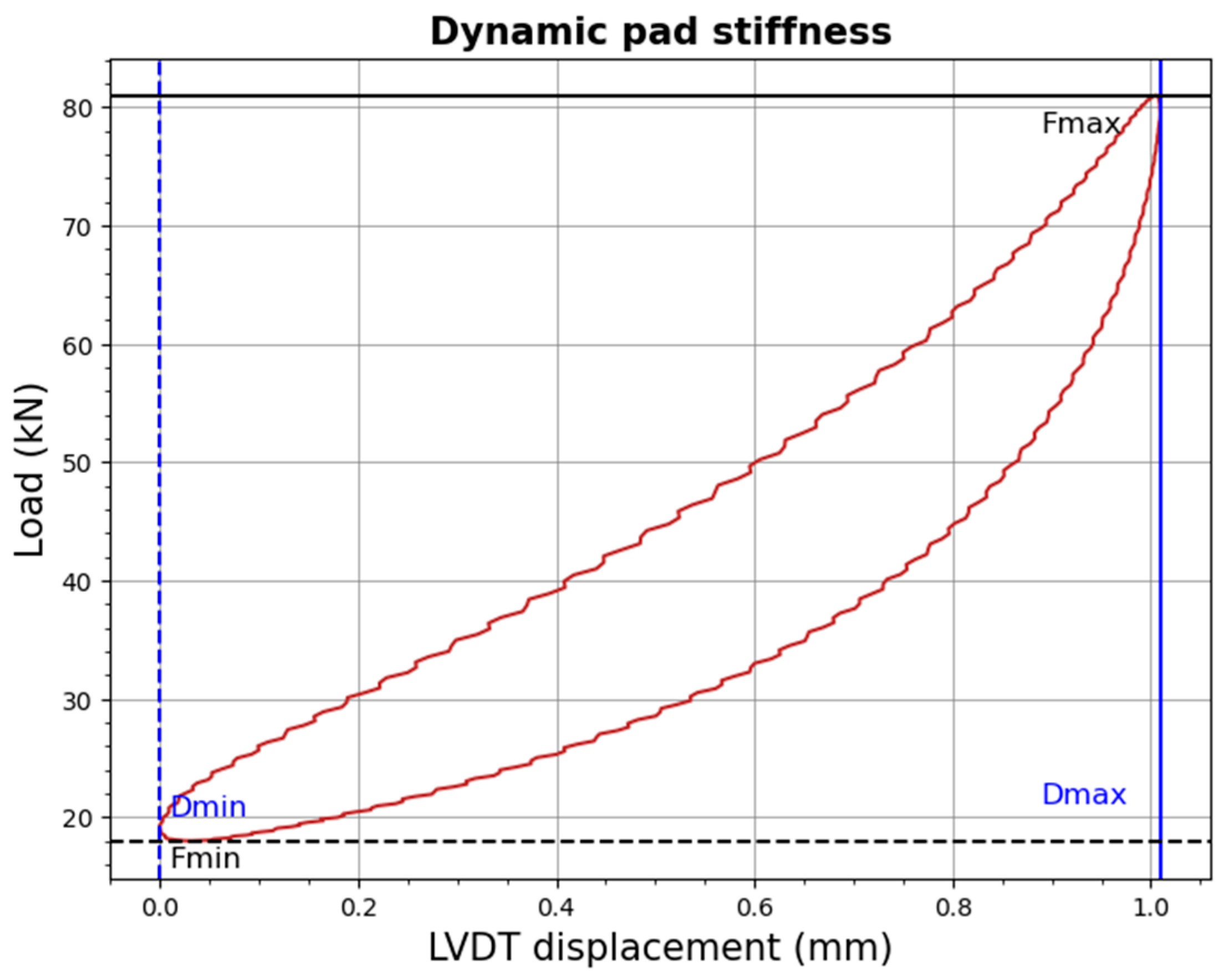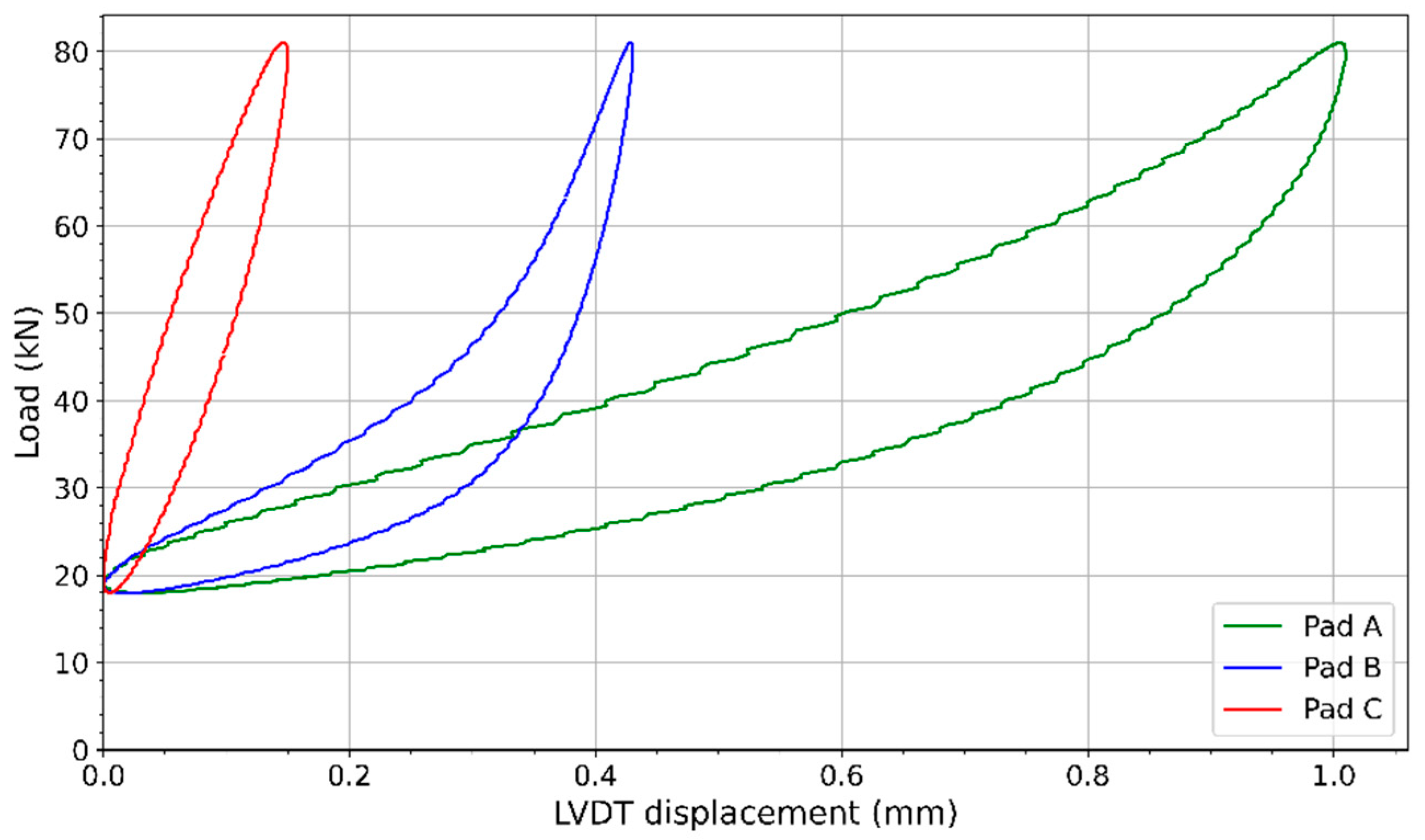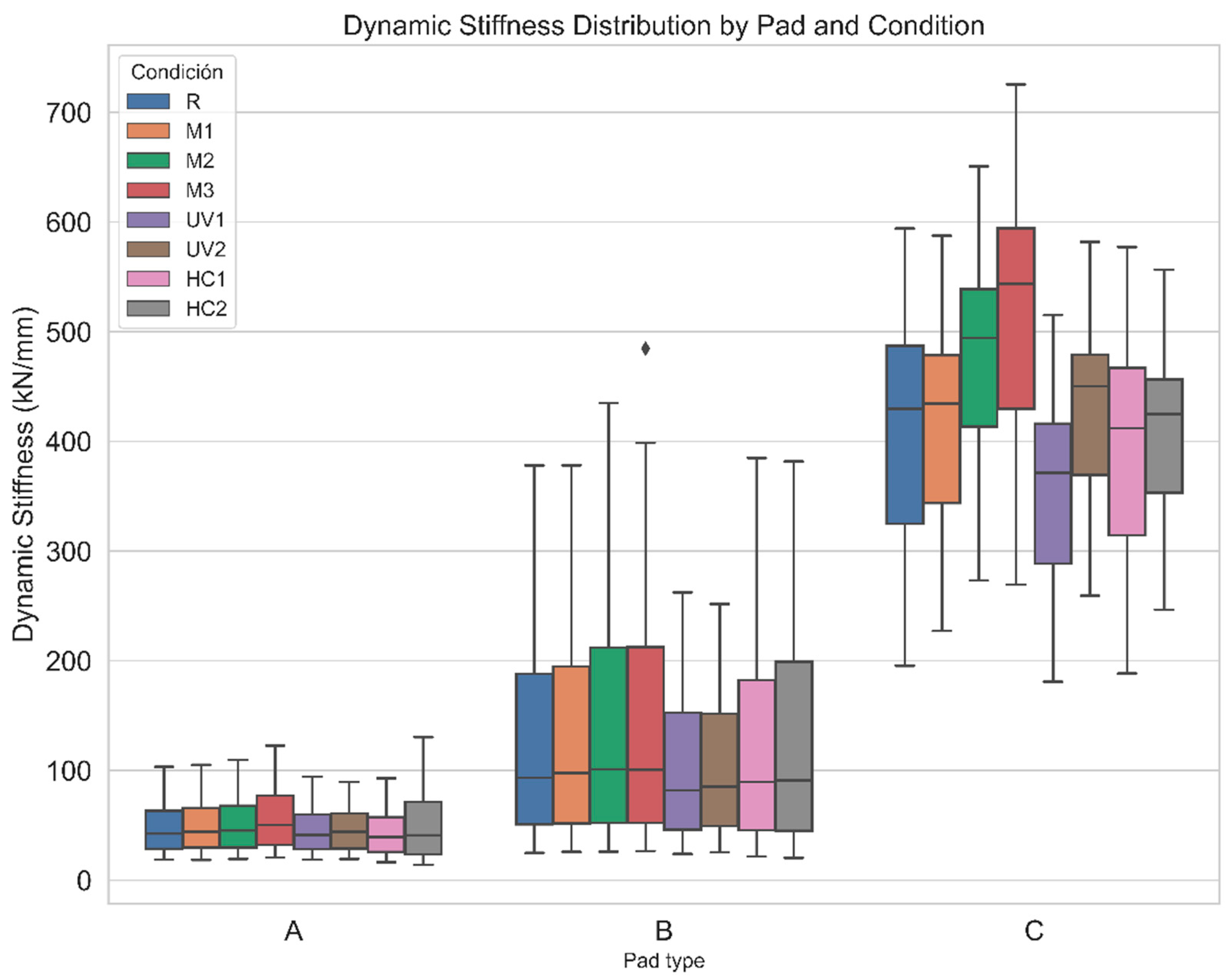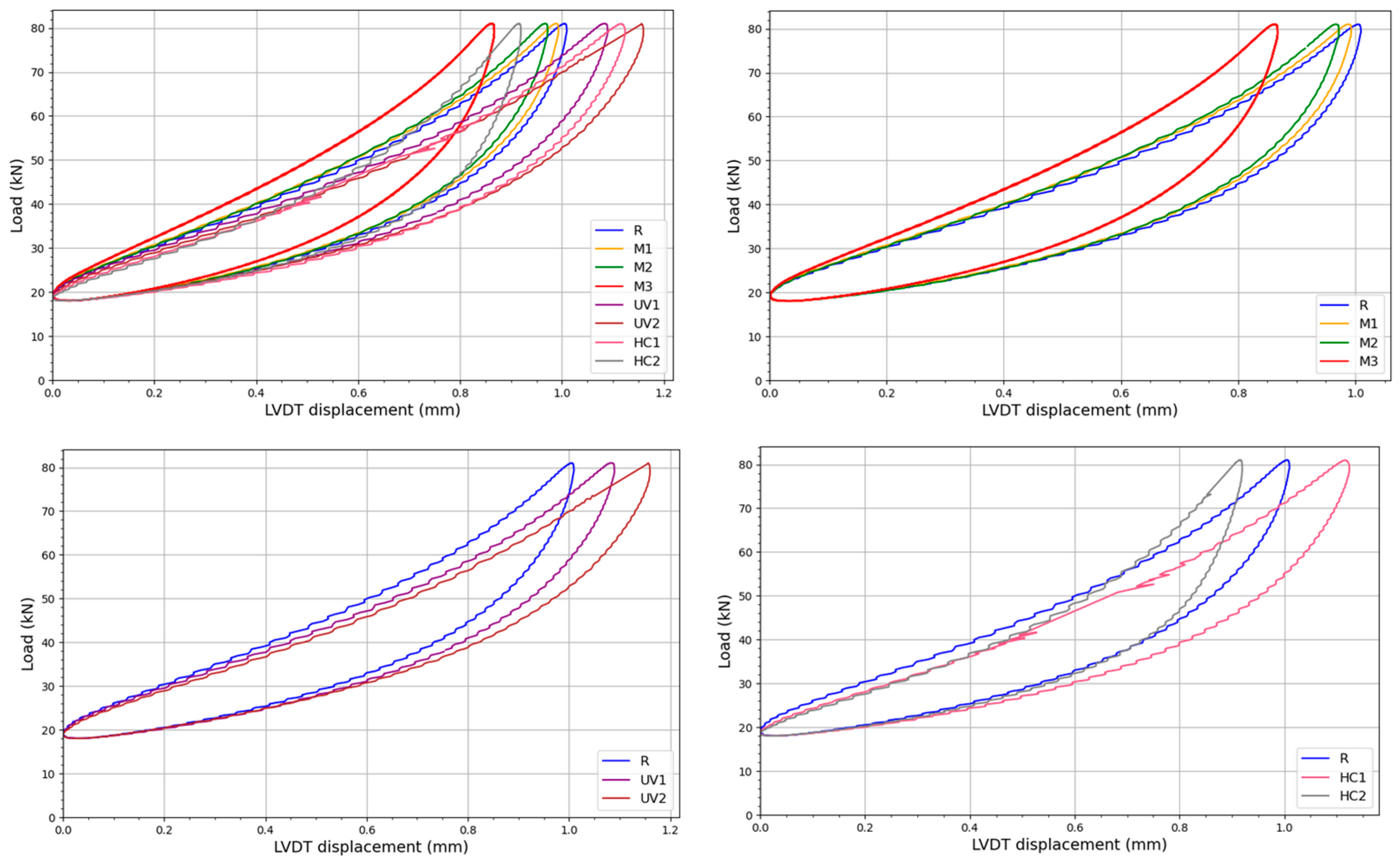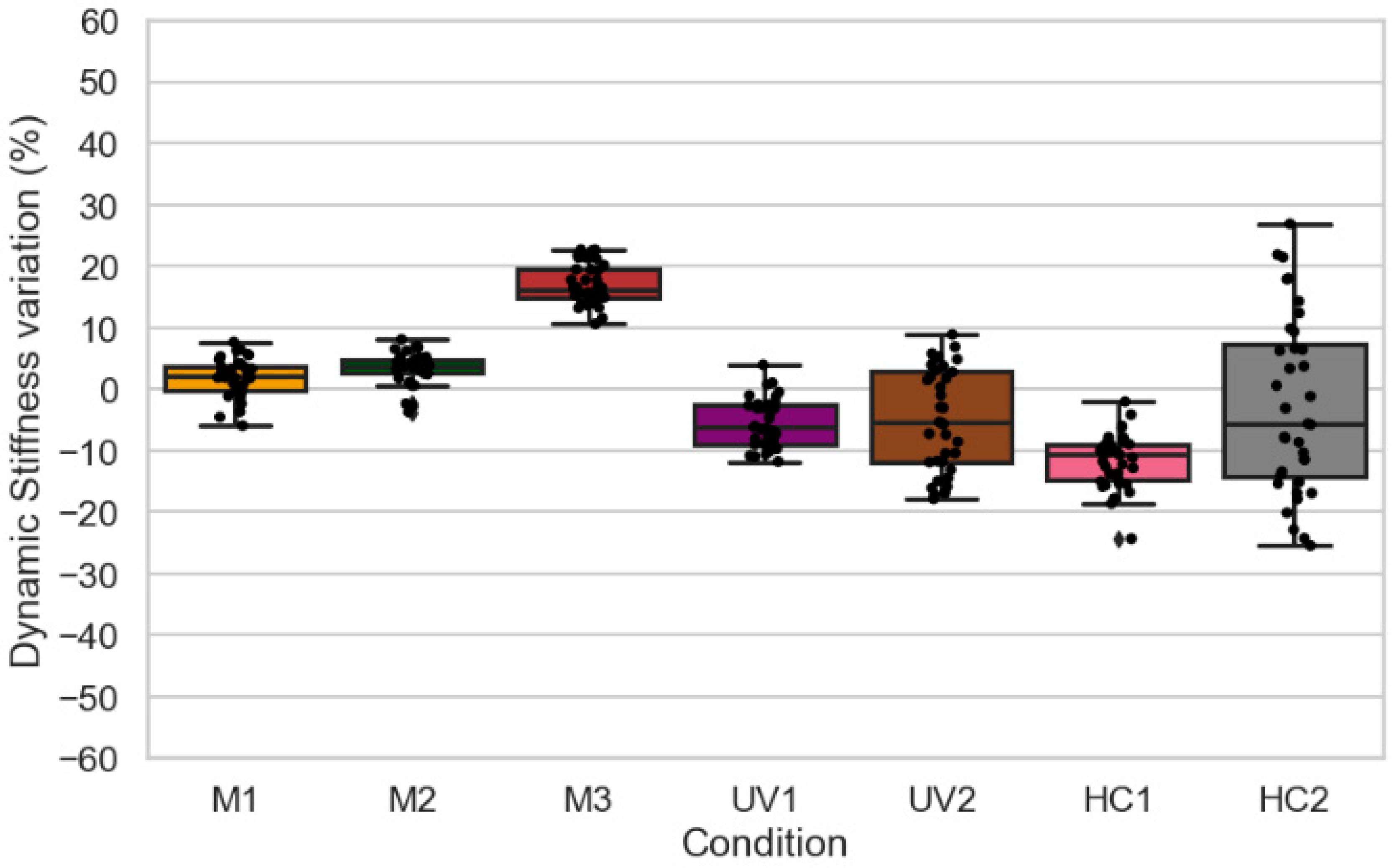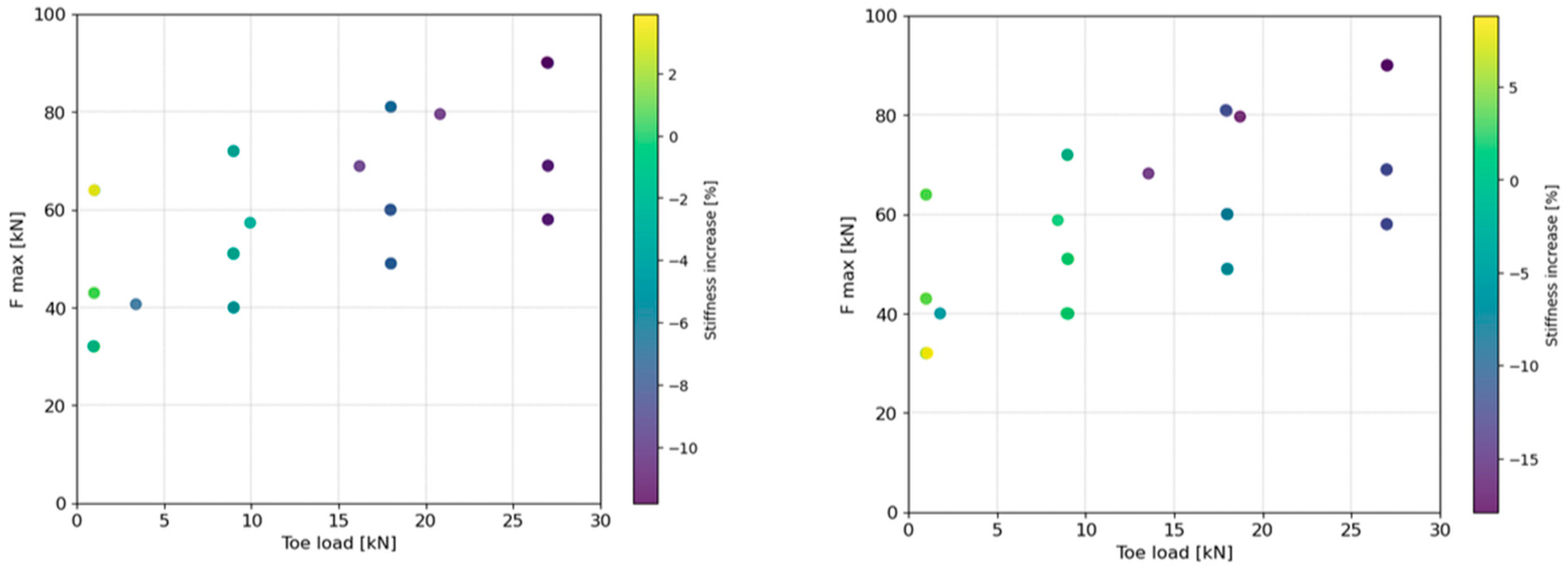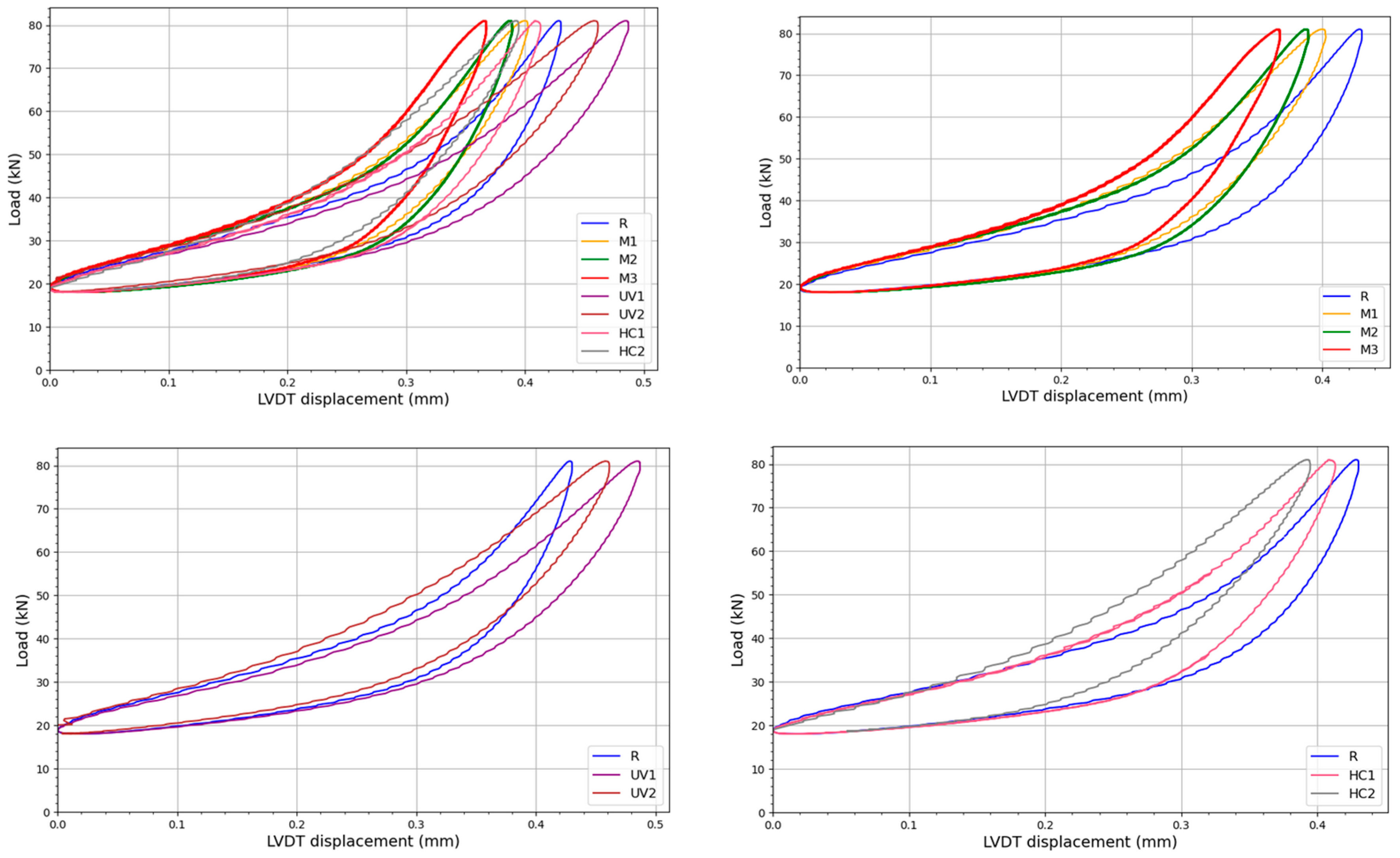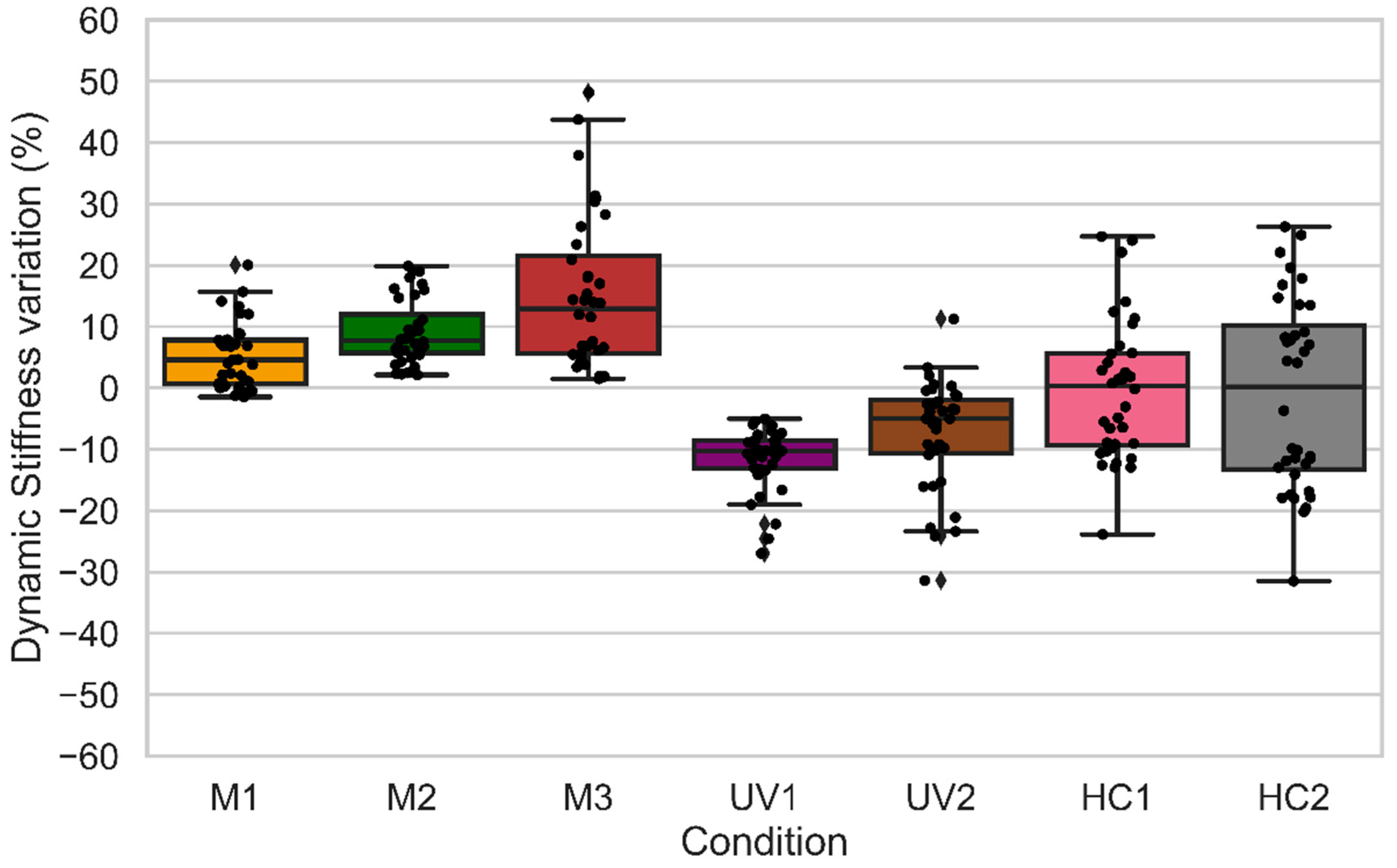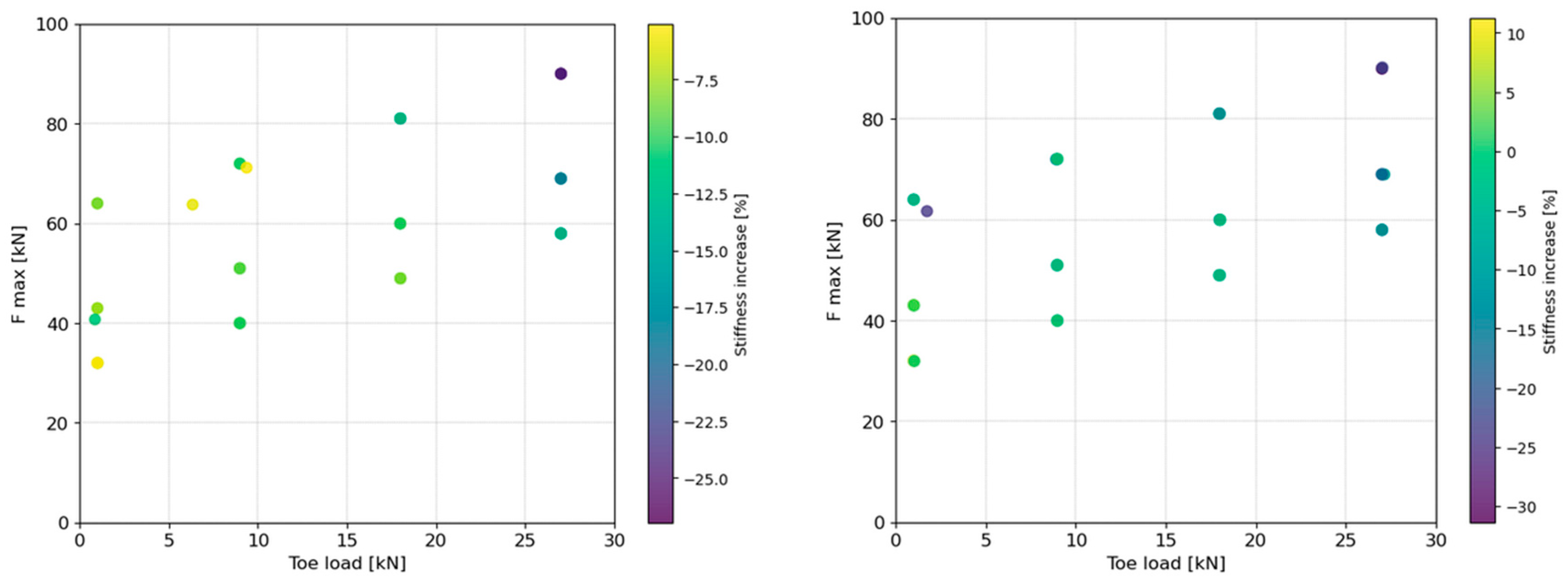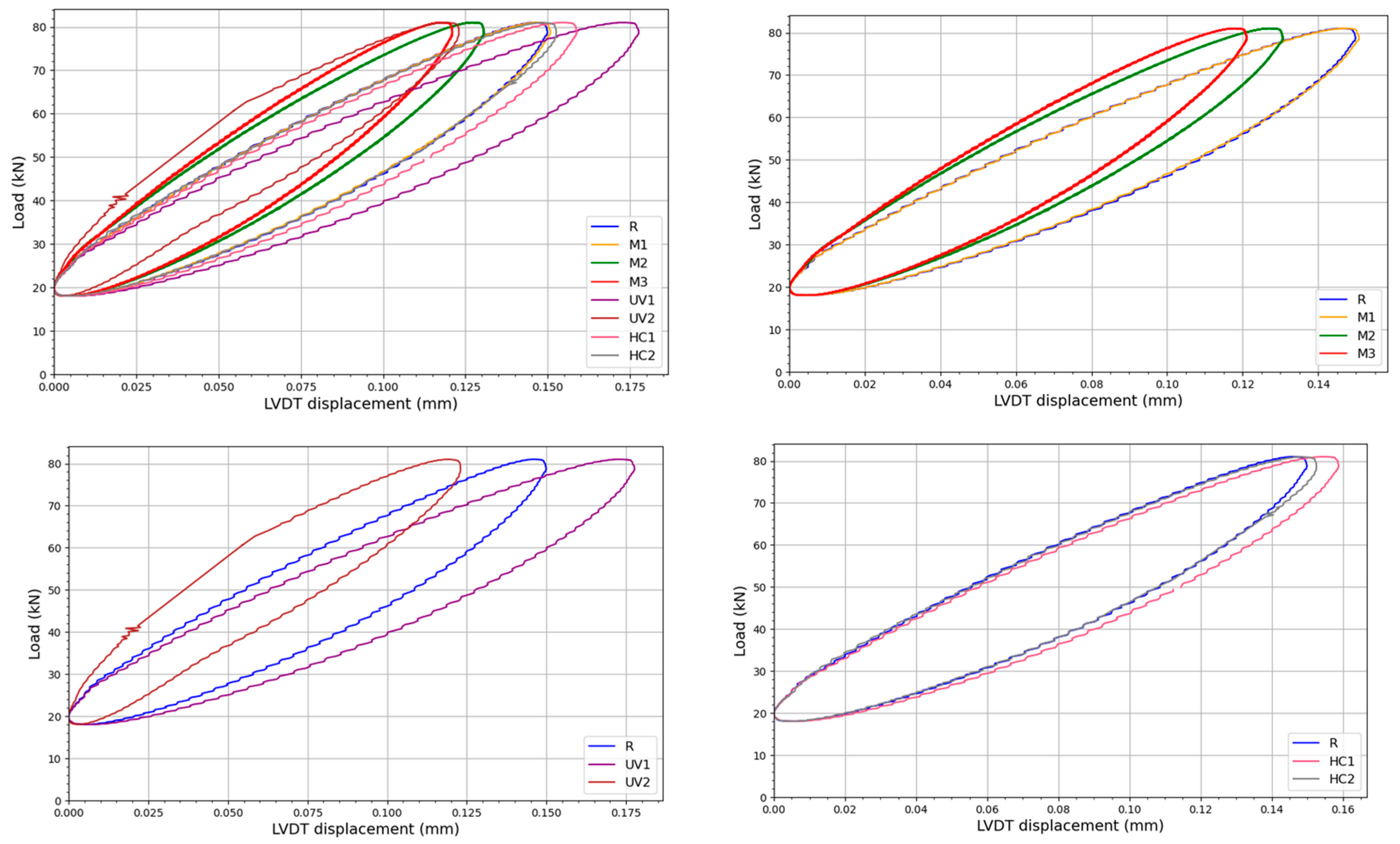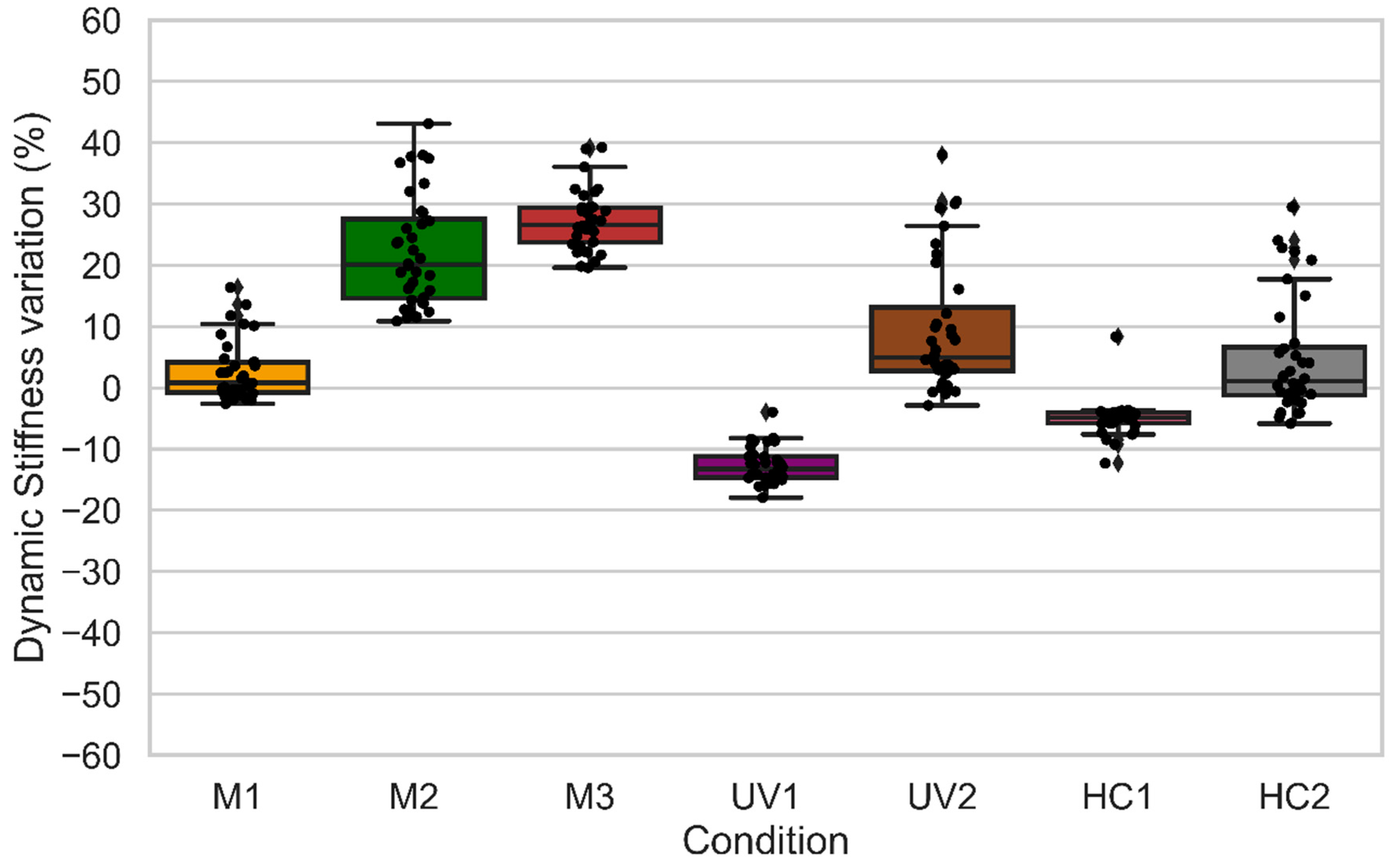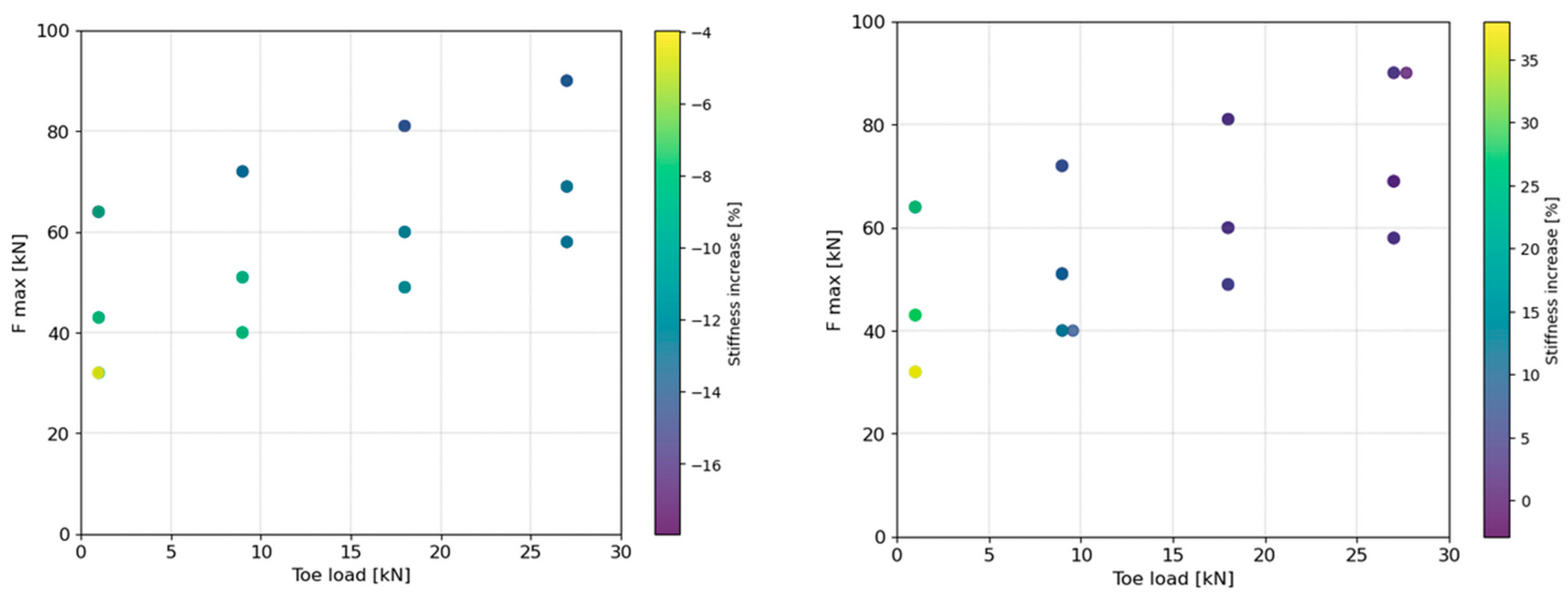1. Introduction
Railway has been, since its inception, one of the main modes of transportation, thanks to its ability to move large volumes of both passengers and goods efficiently and sustainably. Specifically, within the European Union, the railway sector stands out as a benchmark for environmental sustainability. It is the only mode of transport that has consistently reduced greenhouse gas emissions since 1990. In this context, rail is responsible for transporting 13% of freight and 7% of passengers, while its emissions account for only 0.4% of the total emissions from the transport sector [
1]. Additionally, the sector has demonstrated steady growth, with annual increases of 2.5% in passenger traffic and 4.1% in freight transport [
1]. According to the Rail Market Monitoring report by the European Commission [
1], 38.7 billion euros were invested in rail infrastructure in 2018, with 53% of that investment dedicated to maintenance and renewal, particularly of the track superstructure.
The railway superstructure is a composite system of various elements responsible for transmitting the dynamic load of vehicles to the ground, ensuring passenger comfort, and reducing vibrations and noise emissions. The components that comprise the railway superstructure include rails, clips, bolts, dowels, ribbed plates, and rail pads, as illustrated in
Figure 1. In the ballasted track typology, the system is fixed to sleepers resting on the mass of the ballast, while in the slab track typology, the system is attached to the concrete slab. The vertical stiffness of the track is a crucial variable that significantly impacts the quality of transportation, as well as its maintenance and durability.
In ballasted tracks, the vertical stiffness of the assembly is jointly determined by the stiffness of the ballast and the rail pads [
2], while in slab track systems, the vertical stiffness depends almost entirely on the rail pads [
3]. This finding is supported by the study by Chen et al. [
3] in which the authors employed Finite Element modeling to investigate the dynamic behavior of high-speed tracks. The pioneering study by Dean and Harrison in 1982 [
4] aimed to identify the cause and recommend a solution for the development of rail seat bending cracks observed in concrete sleepers on several tracks with service histories ranging from a few months to about two years. The major objective of this experimental study was to identify a value of the pad stiffness to prevent the initiation of cracks in sleepers subjected to the worst in-service impact conditions [
5]. Subsequent studies were conducted to further understand the influence of the stiffness of the system. Specifically, previous research [
5,
6] has noted that an increase in pad stiffness leads to a reduction in impact attenuation capability, thereby causing the deterioration of the sleepers and ballast. Insufficient stiffness, as documented in the literature [
7,
8], has been reported to result in excessive deflection of the rail, higher energy consumption, and increased accelerations experienced by the vehicles. These findings provide valuable insights into the relationship between stiffness and the performance of high-speed tracks, which can inform the design and maintenance of these systems.
Rail pads are essential components of railway track systems because they play a crucial role in improving load distribution, providing flexibility, damping the impact of loads, reducing noise and vibrations, and providing electrical insulation between rails [
9]. The market offers a wide range of rail pad solutions, differing in size, constituent material (natural rubber, synthetic rubber, plastics, composites, etc.), and surface geometry (plain, grooved, prismatic, and studded patterns). Typically, rail pads are rectangular in shape, measuring 180 mm in length, 140–150 mm in width, and ranging in thickness from 4.5 to 15.0 mm. The mechanical behavior of polymeric materials used to fabricate rail pads is nonlinear and dissipative and is affected by several in-service conditions such as temperature, frequency, tow load, and axle load. In a previous study by Sainz-Aja et al. [
10], three types of rail pads fabricated using EPDM, TPE, and EVA were exhaustively characterized (720 tests) under different combinations of the aforementioned factors to determine their influence on the dynamic stiffness of the component. This experimental information was subsequently modeled using Machine Learning algorithms. The analysis of feature importance revealed that temperature and tow load are the most influential variables affecting the dynamic stiffness of EPDM and TPE rail pads, while tow load is the most significant feature for EVA rail pads. Finally, in Sainz-Aja et al. [
11], a Finite Element model of the slab track was developed to generate synthetic samples representative of actual in-service conditions where relevant track parameters were varied within their usual ranges using a Monte Carlo procedure. The results were then used to train and validate a series of regression Machine Learning models, which showed that the properties of the soil, characteristics of the rail pads, and axle loads have the greatest influence on the railway infrastructure.
Polymer materials utilized in the railway superstructure are susceptible to degradation under various environmental conditions [
12]. Such conditions encompass low and/or high temperature, exposure to rain and/or sunlight, water and/or soil properties, inducing different kinds of degradation mechanisms such as oxidation, hydrolysis, ultra-violet (UV) irradiation, chemical influence, aging or fatigue, among others. A paper authored by Sol-Sánchez et al. [
7] outlines the degradation mechanisms (physical–chemical and mechanical) experienced by rail pads exposed to the railway environment. The authors reported that environmental factors can cause the pads to progressively increase in stiffness, with values reaching up to 33–41% for a service life of 1–3 years, respectively.
There is a recent bibliography on the aging and changes in the mechanical behavior of the materials used in this study. In this sense, Tayefi et al. [
13] show that under accelerated thermal aging, EPDM undergoes oxidation at high temperatures (120–140 °C) that generates hydroxyl and carbonyl groups, reducing its crystallinity and deteriorating its mechanical properties. Likewise, Xin-Yi et al. [
14] investigate γ-ray irradiation, finding that it reduces the Mooney viscosity and molecular weight of EPDM, increases the gel content, and raises the glass transition temperature, which modifies its internal structure and processing performance; finally, Shuang-Hong et al. [
15] examine the thermo-oxidative aging of EPDM, noting that crosslinking predominates during degradation, which translates into an increase in hardness and tensile strength along with a decrease in permanent deformation. In the case of EVA, Oliveira et al. [
16] present a review in which the degradation of the EVA encapsulant used in photovoltaic modules is described under the influence of environmental factors (temperature, humidity, and UV radiation), affecting its chemical, mechanical, optical, and electrical properties, which in turn reduces the system’s efficiency and durability. Other authors report similar results; for example, Ji et al. [
17] show that during thermo-oxidative aging at 165 °C in air, EVA degrades mainly due to the decomposition of its acetate groups, leading to significant changes in its electrical and mechanical properties.
This research aims to experimentally evaluate how mechanical and environmental deterioration conditions affect the dynamic stiffness of rail pads manufactured from EPDM and EVA materials. Based on the literature review, it has been established that there are existing studies addressing the aging and changes in the mechanical behavior of EPDM and EVA materials under various environmental conditions [
13,
14,
15,
16,
17], as well as research identifying specific degradation mechanisms in rail pads exposed to the railway environment [
7]. However, no specific study has been conducted to quantitatively measure the magnitude of these effects on real components subjected to conditions representative of the railway environment. The mechanical deterioration caused by repetitive loads was examined by applying load blocks of 250,000, 750,000, and 2,000,000 cycles. Chemical deterioration was also investigated by exposing the rail pads to ultraviolet radiation and to the presence of hydrocarbons, respectively. In both cases, exposure times of 100 and 500 h were utilized. Overall, the study encompasses 21 distinct experimental conditions (three types of pads and seven deterioration conditions), resulting in a comprehensive experimental scope consisting of 864 tests.
The remainder of this paper is structured as follows:
Section 2 describes the rail pads that were characterized in this study.
Section 3 outlines the experimental methods employed to obtain the stiffness of the pads, along with the experimental conditions that were utilized. The obtained results are presented and discussed in
Section 4. Finally,
Section 5 provides a summary of the findings and presents the conclusions that can be drawn from this study.
3. Methods
The objective of this work is to experimentally quantify the influence of mechanical and environmental factors on the performance of EPDM and EVA rail pads. For this purpose, 21 combinations of aging scenarios were analyzed, and the results were compared with tests on identical rail pads used as a reference, which were not subjected to any degradation conditions. Each scenario corresponds to the application of one of the seven types of experimental degradation conditions to each pad model, adding one more for the reference condition. The 864 dynamic stiffness tests conducted resulted from combining all the main test parameters, which are three load amplitude values (15.5, 21, and 31.5 kN), four tow load values (1, 9, 18, and 25 kN), and three test frequencies (5, 10, and 20 Hz) for each pad model, collected in
Table 1. All these tests were carried out in accordance with the European Standards UNE-EN 13146-9 [
18] and UNE-EN 13481-2 [
19].
3.1. Degradation Conditions
The three types of pads were subjected either to a mechanical or a chemical degradation process, as described next.
Table 2 summarizes the different conditions imposed.
The mechanical degradation resulting from the repeated passage of trains was simulated experimentally by subjecting the rail pads to cyclic loading under typical high-speed conditions. For this purpose, a load amplitude of 31.5 kN, a preload of 18 kN, and a frequency of 5 Hz were applied. The extent of damage was regulated by varying the number of cycles applied, considering three levels: 250,000, 750,000, and 2,000,000 cycles.
Chemical degradation is intended to replicate the impact of various agents to which the pads may be exposed throughout their service life on the track. Two aging conditions were considered: exposure to ultraviolet (UV) light and exposure to hydrocarbons. For both cases, the effects were assessed after 100 and 500 h of exposure.
The UV exposure tests were conducted using an Atlas UV2000 (manufacturer: Atlas MTS, made in USA) testing device. Samples were subjected to sequential 6 h cycles, each consisting of 5 h of UV radiation exposure at 50 °C with an energy intensity of 0.77 W/m2·nm, provided by UV-430 fluorescent lamps, followed by a 1 h water spray period. For hydrocarbon resistance tests, rail pads were immersed in NUTO H-46 oil, commonly utilized for lubricating industrial equipment and hydraulic systems in the railway sector. Samples were kept submerged for durations of either 100 or 500 h.
3.2. Mechanical Characterization: Dynamic Stiffness Tests
Stiffness tests were conducted using a universal servo-hydraulic testing machine equipped with a ±100 kN capacity load cell, as can be shown in
Figure 3. The deformation of the rail pads was recorded using four Linear Variable Differential Transformers (LVDTs) mounted on a metallic base replicating the sleeper’s geometry. The loads were applied to the rail pads through a UIC60 rail sample, which was connected to the testing machine via a ball joint to ensure the vertical alignment of the applied load. Throughout the tests, both the vertical load and the rail pad deformation were measured, with the latter calculated as the average of the four LVDTs.
According to standards UNE-EN 13481-2 [
19] and UNE-EN 13146-9 [
18], dynamic stiffness was determined by subjecting the rail pad to 1000 sinusoidal load cycles. An example of a force-displacement curve required to evaluate the dynamic stiffness of the pads is presented in
Figure 4.
The dynamic stiffness of the rail pads was calculated as the ratio of the average load range to the average displacement range over the final 100 cycles of each test, as expressed in Equation (1):
The standard establishes a reference frequency of 5 Hz but allows testing at 10 and 20 Hz for specific cases, so tests were conducted at these three frequencies. Regarding load amplitude, the standard provides different values based on the track category; therefore, all specified values (15.5, 21.0, and 31.5 kN) were considered. For the minimum test load, the standard specifies a value of 18 kN, representing the fastening’s tightening. However, since fastening tightening varies significantly, four different minimum load values were selected: 1 kN (simulating a broken fastening), 9 kN (loosened fastening), 18 kN (reference condition), and 25 kN (overtightened fastening).
4. Results
Figure 5 shows the differences in dynamic stiffness obtained when evaluating the three reference pads under the standard parameters for high-speed railways (5 Hz frequency, 31.5 kN amplitude, and 18 kN toe load). These parameters will serve as a reference for the comparative analysis of the dynamic stiffness curves recorded under the different experimental conditions, which are presented in subsequent graphs for each of the pads analyzed.
Figure 6 provides an overview of the behavior, presenting box plots that illustrate the distribution of dynamic stiffness for each pad and experimental condition. It can be observed that pad A exhibits the lowest stiffness and variability compared to the other two types. The average values range from 43 kN in condition HC1 to 58 kN in condition M3, while the reference pad achieves an average of 49 kN. The standard deviation ranges between 20 and 30 kN.
Pad B presents a mean stiffness value ranging from 101 kN in the UV1 condition to 146 kN in the M3 condition, with a standard deviation that increases significantly, fluctuating between 66 kN and 122 kN; thus, this material exhibits the greatest variability among the three pads analyzed.
Regarding pad C, a high dispersion in its values is also observed. It is also the stiffest of the three pads analyzed, with stiffness values ranging from 348 kN in condition UV1 to 506 kN in condition M3, while the standard deviation varies between 83 kN and 125 kN.
Figure 7 is presented to illustrate the mean relative stiffness of the different degradation agents compared to the reference pad. This behavior is analyzed in greater detail in
Section 4.1,
Section 4.2 and
Section 4.3, where the effects of each condition will be examined individually.
4.1. Type A Pads
Dynamic stiffness curves obtained from tests on the various conditions of pad A, conducted under the aforementioned reference parameters, are depicted in
Figure 8. The results indicate that mechanical degradation increases the stiffness of the pads as the number of cycles increases, while exposure to UV radiation causes a decrease in stiffness. In the case of hydrocarbons, a mixed effect is observed: the condition with higher exposure increases stiffness, whereas that with lower exposure reduces it.
The boxplot diagram presented in
Figure 9 illustrates the variation in dynamic stiffness obtained for the different combinations of test parameters compared to the value obtained in the reference pad, allowing visualization of the distribution of stiffness variation for each case and condition. It is observed that the influence of mechanical degradation progressively intensifies, with mean increases in dynamic stiffness of 2%, 3.5%, and 17% for M1, M2, and M3, respectively, while exposure to UV light reduces dynamic stiffness by 5.5% and 5% for UV1 and UV2, respectively, thereby increasing the dispersion relative to the effects of mechanical degradation. On the other hand, exposure to hydrocarbons results in an average variation in dynamic stiffness of −11.5% for HC1 and −3% for HC2; in the latter case, a high dispersion in the data is observed, with some measurements showing increases in dynamic stiffness of over 20%, while others exhibit decreases of more than 20%.
To explain the greater dispersion observed in the chemical degradation results, especially in cases of higher exposure, a scatter diagram is presented in
Figure 10 that correlates the rail pad stiffness with the tow load and the maximum load applied during dynamic tests. The stiffness variation is represented using a color scale. This diagram reveals that in the case of UV radiation exposure, an increase in stiffness is observed with the application of low loads, whereas as the load increases, the stiffness decreases. Moreover, this behavior intensifies as exposure to UV light increases.
A scatterplot similar to
Figure 10, used to analyze the exposure of the same rail pads to hydrocarbons, has already been presented and studied by the same authors in a previous publication [
20].
4.2. Type B Pads
Dynamic stiffness curves experimentally obtained for the different conditions of pad B reveal that, in the case of mechanical degradation, the behavior is similar to that of pad A, with a constant increase in stiffness as exposure increases. UV exposure results in a decrease in stiffness, although the effect is more pronounced under lower exposure conditions, while exposure to hydrocarbons tends to reduce stiffness as exposure increases, as illustrated in
Figure 11.
The variation in dynamic stiffness of pad B, as illustrated in the plots in
Figure 12, is similar to that observed in pad A, showing average increases of 5.5%, 9%, and 15% for the M1, M2, and M3 conditions, respectively. Exposure to UV light reduces stiffness by 11.5% and 7.5% for UV1 and UV2, respectively. With regard to hydrocarbon exposure, the average variation indicates a slight reduction in dynamic stiffness, close to −1%, affecting both exposure levels similarly. It is worth noting that although the dispersion of results is comparable for conditions HC1 and HC2, lower variability is observed in HC2, whose data cluster into two trends: one that increases stiffness by between 10% and 20% and another that reduces it by a similar ranger.
Figure 13 provides evidence of behavior similar to that observed in pad A regarding UV exposure, although the magnitude of the effects is greater for this pad.
4.3. Type C Pads
Dynamic stiffness curves obtained from tests for the different conditions of pad C reveal an increase in stiffness with escalating mechanical degradation, although no effect is observed under low exposure levels. UV light exposure exhibits a mixed effect, decreasing stiffness under low exposure conditions while increasing it under more intense exposures, whereas the influence of hydrocarbon exposure is relatively mild, causing a slight reduction in stiffness as exposure increases, as shown in
Figure 14.
Pad C shows, through the boxplots presented in
Figure 15, an increase in stiffness under the mechanical degradation conditions M1, M2, and M3 of 2.5%, 22%, and 27%, respectively. Regarding exposure to UV light, a decrease of 13% is observed for UV1 and an increase of 9.5% for UV2. On the other hand, exposure to hydrocarbons reduces dynamic stiffness by 5% under HC1, whereas in HC2, a 5% increase is recorded.
Figure 16 shows that exposure to UV light produces a mixed effect on this pad; it reduces the stiffness in conditions of low exposure and increases it in those of higher exposure. In addition, it is observed that, for small load values, the stiffness is higher in both cases.
5. Discussion
This study has analyzed the influence of the main mechanical and chemical aging processes to which rail pads are subjected during their service life, demonstrating their effect on the dynamic stiffness of three different types of pads manufactured with EPDM and EVA, materials commonly used by rail pad manufacturers. To achieve this, an experimental program was carried out that included 864 dynamic stiffness tests under different degradation scenarios. The results allow for a more detailed understanding of how degradation mechanisms affect the dynamic stiffness of the pads under various aging conditions, which is fundamental for the proper design and maintenance of the railway superstructure.
The importance of the degradation of polymers used in the railway sector has been demonstrated by Ito et al. [
12], who showed in their article how the mechanical properties of rail pads are affected by exposure to temperature, ultraviolet (UV) radiation, and degradation by chemical, biological, and mechanical agents. Mechanical degradation progressively increases the dynamic stiffness in all types of pads, with the most notable increase observed in the EVA pad (pad C in this study), which reached a 27% increase in the 2,000,000-cycle scenario. These results agree with those obtained by Carrascal et al. [
21], who observed significant increases in both static and dynamic stiffness for EPDM rail pads subjected to mechanical fatigue aging. One possible reason for these results is that the loads experienced by the rail pads may lead to a reduction or deformation of the protrusion area, resulting in an increase in stiffness. This hypothesis is consistent with the findings of Sol-Sánchez et al. [
22], who observed that the permanent deformation experienced by rail pads due to fatigue and repeated loading causes a significant increase in their dynamic stiffness. Specifically, they found that pads exhibiting greater permanent deformation after repeated loading cycles also showed greater increases in stiffness. UV exposure has different effects depending on the material and the pad, although a general trend is observed in all cases: for low exposures, the stiffness is lower than for high exposures. This is most evident in the case of pad C, manufactured in EVA, where a 13% decrease in dynamic stiffness is observed under the lowest exposure condition and a 9.5% increase under the highest exposure. The effect of UV exposure on polymers has been studied by other authors [
12,
23], such as Jin et al. [
23], who demonstrated that exposure to UV light causes modifications in the structure of the EVA polymer, affecting its mechanical properties so that short exposures improve mechanical behavior while prolonged exposures deteriorate it. These findings differ from those obtained in the present study, where it is observed that, in the case of rail pads, geometry plays a crucial role, as noted by other studies [
10,
24]. It is likely that, under low exposure conditions, material degradation reduces the load-bearing capacity of the protrusions, leading to a decrease in dynamic stiffness, while for higher exposure conditions, their load-bearing capacity is exhausted, which would induce an increase in stiffness, as seen in
Figure 16 Furthermore, it should be noted that the evaluation of mechanical properties by Jin et al. [
23] is carried out through tensile tests, whereas in the present study, dynamic stiffness was obtained through compression fatigue tests at different frequencies. Hydrocarbon exposure also produces different effects depending on the material and the pad. In the case of pad A, a reduction in stiffness is observed under both conditions, with an 11.5% loss at the lower exposure level and a partial recovery, reaching only a 3% decrease at the higher exposure level. On the other hand, a slight 5% increase was recorded for pad C under prolonged exposure. Our conclusions agree with those previously obtained by Sainz-Aja et al. [
20].
In the case of exposure to hydrocarbons and UV radiation, the observed differences in effects between rail pads and exposure levels could reasonably be attributed to the substantial differences in how the polymer chains constituting EPDM and EVA respond to degradation processes. Thus, previous studies have already indicated the difference in the deterioration caused by environmental agents between different polymers [
7]. Specifically, the distinct chemical structure of each material influences its degradation mechanisms, resulting in different behaviors under identical environmental conditions. In this way, the variations in dynamic stiffness observed in this study reflect the underlying chemical and structural characteristics unique to each polymer [
13,
14,
15,
16,
17], affecting their performance and durability in real operating scenarios.
Finally, although this study provides insights into the degradation mechanisms and their effects on the dynamic stiffness of rail pads made of EPDM and EVA, there are several important limitations that must be acknowledged. Firstly, while the experimental tests consider representative conditions of the railway environment, the effects of mechanical aging, ultraviolet radiation, and hydrocarbon exposure were evaluated separately without analyzing the possible interactions or simultaneous combinations of these factors, which may occur under real service conditions. Additionally, the study focuses exclusively on two specific materials with specific geometries, implying that the results obtained within this research may not be totally generalizable to other different components.
6. Conclusions
This study provides a detailed characterization of some of the main degradation mechanisms affecting the service life and performance of rail pads, which are essential components for ensuring the safety, comfort, and durability of railway infrastructure. Through experimental tests carried out under conditions representative of the railway environment, it has been established that the aging behavior significantly depends on both the material used (EPDM or EVA) and the geometry of the component. Additionally, the study quantitatively evaluates how specific variables, such as mechanical fatigue, ultraviolet radiation, and exposure to hydrocarbons, influence the dynamic stiffness of these components. These results allow for a more precise selection of rail pad materials and designs based on the specific operational conditions they will face in service. Furthermore, the insights gained provide the foundation for optimizing preventive maintenance strategies by enabling a more accurate understanding of track stiffness, thus contributing to reduced operating costs, minimized service disruptions, and extended component lifetimes. Future research should address the combination of different degradation agents on the same rail pad, as well as further explore the role that geometry plays in its deterioration.
In conclusion, this study has provided a detailed characterization of how mechanical and chemical aging processes influence the dynamic stiffness of rail pads manufactured with EPDM and EVA, materials widely used in the railway industry. The results show that mechanical degradation progressively increases the dynamic stiffness of rail pads, with EVA pads being the most affected, exhibiting stiffness increases of up to 27%. On the other hand, exposure to UV radiation produced variable effects depending on exposure intensity and pad geometry, initially decreasing stiffness at lower exposures and subsequently increasing it at prolonged exposures. Additionally, hydrocarbon exposure also revealed different behaviors depending on the material type. These findings highlight the importance of considering aging mechanisms in the selection and proper maintenance of rail pads, laying the groundwork for future research on combined effects and the influence of pad geometry.
